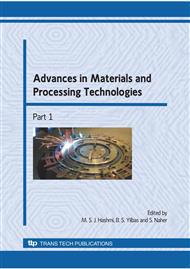p.1190
p.1197
p.1205
p.1212
p.1220
p.1228
p.1236
p.1243
p.1251
Towards Tool Path Numerical Simulation in Modified Friction Stir Spot Welding Processes
Abstract:
Spot welding can be considered a very common joining technique in automotive and transportation industries as it permits to obtain effective lap-joints with short process times and what is more it is easily developed through robots and automated systems. Recently the Friction Stir Spot Welding (FSSW) process has been proposed as a natural evolution of the already known Friction Stir Welding (FSW) process, allowing to obtain sound spot joints that do not suffer from the insurgence of typical welding defects due to the fusion of the base material. In the paper, a modified Friction Stir Spot Welding (FSSW) process, with a spiral circular movement given to the tool after the sinking stage, is proposed. A continuum based numerical model for Friction Stir Spot Welding process is developed, that is 2D Lagrangian implicit, coupled, rigid-viscoplastic. This model is used to investigate the distribution of the main field variables, namely temperature, strain and strain rate, as well as the Zener-Hollomon parameter which, in turn, strongly affects the Continuous Dynamic Recrystallization (CDRX) process that takes place in the weld nugget. Numerical and experimental results are presented showing the effects of the process parameters on the joint performances and the mechanical effectiveness of the modified process.
Info:
Periodical:
Pages:
1220-1227
Citation:
Online since:
December 2009
Authors:
Price:
Сopyright:
© 2010 Trans Tech Publications Ltd. All Rights Reserved
Share:
Citation:


